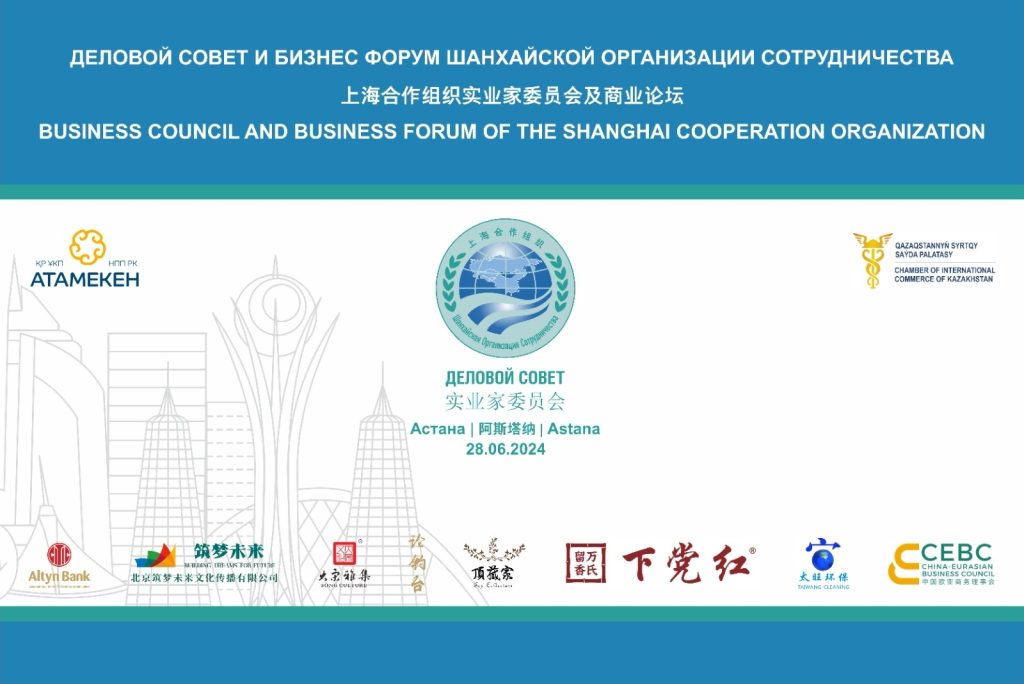
中国-欧亚商务理事会(CEBC)于6月28日成功联合举办了2024年阿斯塔纳上合组织商业理事会和商业论坛会议。此次活动在哈萨克斯坦首都阿斯塔纳举行,由哈萨克斯坦担任主席的上合组织商业理事会、ATAMEKEN全国企业家商会和哈萨克斯坦国际商会共同组织。此次会议是即将于7月3日至4日举行的上合组织峰会的前奏。
The China-Eurasian Business Council (CEBC) has successfully co-organized the 2024 Astana SCO Business Council and Business Forum Meeting on June 28. The event, held in Kazakhstan’s capital Astana, was organized by the SCO Business Council chaired by Kazakhstan, ATAMEKEN – The National Chamber of Entrepreneurs, and the Chamber of International Commerce of Kazakhstan. This meeting is a precursor to the SCO summit scheduled for July 3 and 4.

上合组织商业理事会董事会会议的开幕式吸引了各成员国代表的积极参与,他们对区域内的商业合作潜力充满乐观。CEBC在其会长圣彼霖(Chyngyz Sher)先生的领导下发挥了重要作用。圣彼霖先生不仅是吉尔吉斯共和国商会驻中国官方代表,还担任哈萨克斯坦国际商会和塔什干投资在深圳的名誉代表。
此次活动包括商业论坛、展览和晚宴,旨在促进合作和相互了解。北京筑梦未来文化传播有限公司、河南大宋文化传播有限公司、顶藏家可持续发展咨询(海南)有限公司、上海横燎文化传媒有限公司、福建省万氏留香农业发展有限公司、浙江朗园酒业有限公司、重庆太旺环保工程有限公司、ISACO GROUP(上海国际货运代理有限公司)、深圳吉乐物流网络科技有限公司(GLA Global Logistics Alliance)、深圳市建造工科技有限公司等中国企业的参与是此次活动的一大亮点。
The opening of the SCO Business Council Board meeting saw enthusiastic participation from representatives of various SCO countries, who expressed optimism about the potential for business cooperation within the region. The CEBC, led by Mr. Chyngyz Sher, the official representative of the Chamber of Commerce and Industry of the Kyrgyz Republic in China, the Honorary Representative of the International Chamber of Commerce of Kazakhstan, and Tashkent Invest in Shenzhen, played a crucial role in bringing Chinese companies to the event. This facilitated their engagement with local and SCO government officials, institutions, and leading Kazakh companies.

This event included a business forum, exhibition, and gala dinner, all designed to promote cooperation and mutual understanding. The presence of Chinese companies such as Beijing Build Dream Future Culture Communication Co., Ltd., Henan Song Culture Communication Co., Ltd., Top Collector Sustainable Development Consulting (Hainan) Co., Ltd., Shanghai Hengliao Cultural Media Co., Ltd., Fujian Wanshi Liuxiang Agricultural Development Co., Ltd., Zhejiang Langyuan Liquor Industry Co., Ltd., Chongqing Taiwang Environmental Protection Engineering Co., Ltd., ISACO GROUP (Shanghai International Shipping Agency Ltd.), GLA Co., Ltd. (Global Logistics Alliance), and Shenzhen Constructor Technology Co. was a significant highlight of the event.
这些企业有机会与当地企业签署谅解备忘录,推广品牌,并迈出进入中亚市场的第一步。CEBC的这一举措不仅为中国企业开辟了新的市场机会,还加强了经济联系,促进了未来的国际合作,为中国和欧亚地区带来更多的协同效应。
These cmpanies had the opportunity to sign MOUs with local enterprises, promote their brands, and take the initial steps to enter the Central Asian market. This initiative by the CEBC not only opens new market opportunities for Chinese businesses but also strengthens economic ties and fosters future international collaborations, bringing more synergy between China and Eurasia.


